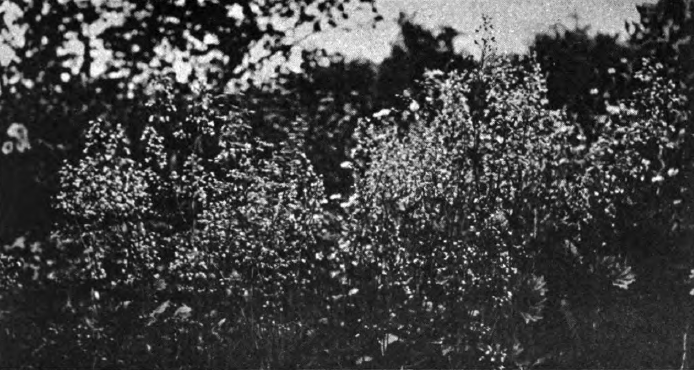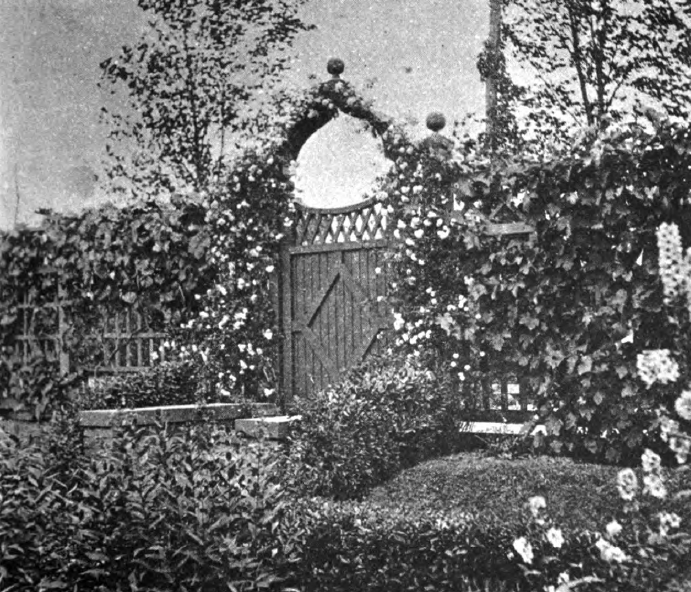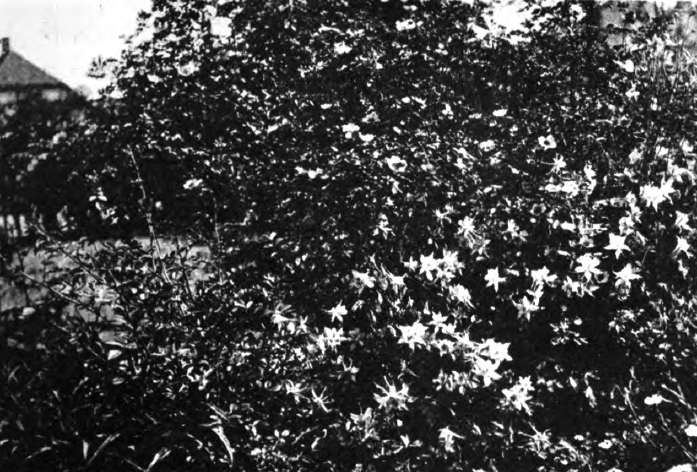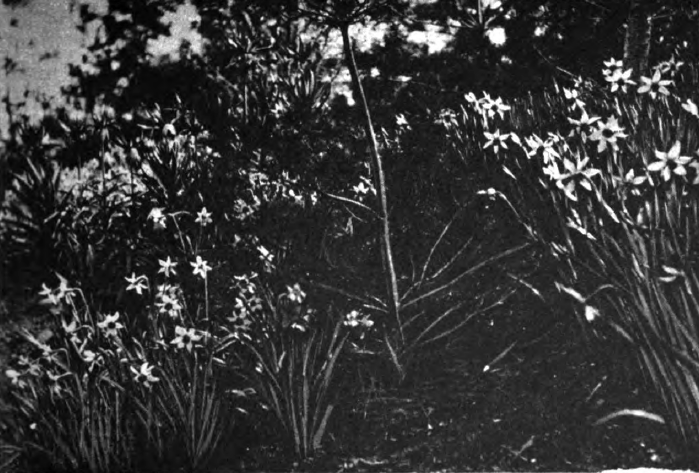| Web
and Book design,
Copyright, Kellscraft Studio 1999-2016 (Return to Web Text-ures) |
 (HOME)
|
|
"Here is a daffodil,
Six-winged as seraphs are; They took her from a Spanish hill, Wild as a wind-blown star. When she was born The angels came And showed her how her petals should be worn. Now she is tame She hath a Latin name." — "A London Flower Show," EVELYN UNDERHILL. JOYS AND SORROWS OF A TRIAL GARDEN THE three indispensable
adjuncts of
a good flower garden, when considering its upkeep, are, in the order of
their
importance: a tool-house well stocked, a good supply of compost, and
space for
a trial garden. In planting for color effect the trial garden is a
necessity.
The space for it may be small: no matter; plant in it one of a kind.
The
gardener happy in the possession of the visualizing sense may take the
one
plant and in his or her imagination readily see its effect as disposed
in rows,
groups, or large masses. My own trial garden space
is very
small; and my idea has been from the first to secure plants for it in
multiples
of four, if possible according to size. The formal flower garden
happens to be
arranged alike in all four quarters of its plan, and this habit of
balanced
planting makes the trying out of eight or sixteen of a kind a really
economical
thing in the end. If the plants please, and the colors form an
agreeable
combination with others already in the garden,. their removal in the
autumn
from trial-garden rows to certain spots in the garden proper, is
simple. A portion of the trial
garden is
kept for seed, and the balance for small collections of bulbs or
plants; except
so much space as is reserved for the fours, eights, and sixteens
mentioned
above. Of Crambe cordifolia, for
example, I should never plant more than four, owing to its great size
and
spreading habit of growth, while of a dwarf hardy phlox eight should be
the
least. It occurs to me often that some of us underestimate the enormous
value
of this wonderful plant. Sure to bloom as is the sun to rise and set,
varying
in its height as few other flowers do, with a range of wonderful color
unsurpassed, perhaps unrivalled, by any hardy flower, the gardener's
consolation in a hot, dry August, when it maketh the wilderness of the
midsummer formal garden to blossom as the rose — there is a delightful
combination of certainty and beauty about it which cannot be
overpraised.
Forbes, the great Scotch grower, in his last list gives six pages of
fine type
to this flower. It is like a clock in its day of bloom, another great
point in
its favor. I have, for instance, three varieties of white which follow
each
other as the celebrated sheep over the wall, each brightening as the
other goes
to seed. No lovelier thing could be conceived than a garden of phloxes,
a
perfect garden of hardy phloxes; in fact, an interesting experiment if
one had
time and space for it would be a garden made up entirely of varieties
of phlox;
beginning with the lovely colors now obtainable in the P.
subulata group, next the fine lavenders of P.
divaricata, then an interim of good green foliage till Miss
Lingard of the P. decussata section
made its appearance, to be followed by the full orchestra of the
general group
of violets and purples (basses); mauves, lavenders, and pinks (violas,
'cellos,
and brasses); and the range of whites (flutes and violins). At the
close of
this concert of phlox-color the audience must leave the garden. The
pity is
that August is its last hour. The strains of glorious music, however,
follow
one over the winter snows. But this ramble has
carried me far
afield. To return to the trial garden — heucheras in the following
varieties
were admitted to this place last fall: brizoides,
gracillima, Richardson, splendens, Pluie de Feu, and Lucifer. They
flourished superbly, although their little roots had been subjected to
the test
of a two weeks' journey by sea and land from an English nursery to
Michigan.
The flower spikes of these hybrid heucheras were thirty-two inches high
by
actual measurement! Another year, when well established, they should
send up
even longer spikes. Their colors vary from very rich coral-red to pale
salmon,
but invariably on the right side of pink — the yellow rather than the
blue.
This encourages me to think of them in connection with sweet-william
Sutton's
Pink Beauty (Newport pink). Next year I hope to see the heucheras' tall
delicate sprays emerging from the flat lower masses of the others'
bloom, since
they flower simultaneously. Long after the sweet-william has gone to
its grave
upon the dust heap, however, the heucheras continue to wave their
lacelike
pennants of bright color. I hardly know of any plant which has so long
a period
of bloom. The only heucheras familiar to me before were the common
species H. sanguinea and the much-vaunted variety
Rosamunde. While these are very beautiful, they have not with me the
height nor
the generally robust appearance necessary for full effect in mass
planting. The
leaves of H. Richardsoni (which are,
as Miss Jekyll points out, at their best in spring, with the bronze-red
color)
make a capital ground cover below certain daffodils and tulips, and
contrast
well with foliage of other tones which may neighbor them in the late
summer.
These heucheras are not common enough in our gardens or in simple
borders.
Their brilliant appearance joined to the long flowering period makes
them
garden plants of rare quality. Let me suggest placing one of the
brighter
varieties before a good group of white Canterbury bells with the same
pink
sweet-William already mentioned near by. By "near by" I mean really
close by, no interfering spaces of earth to injure the effect. I am
unalterably
opposed to gardening in the thin, sparse fashion which some gardeners
affect,
and never let an inch of soil appear. Let the earth be never so good
nor so
carefully weeded and cultivated, it is only now and again that an edge
of turf
should be seen, "in my foolish opinion," as the Reverend Joseph
Jacob's old gardener is apt to remark to his master, the delightful
writer on
flowers. Sixteen peonies with
grand French
names graced my trial garden this year, standing demurely equidistant
from each
other in a stiff row. Their bloom was feeble, small, and hardly worth
noting
for this first season; next year they should be subjects for
observation. It
was a disappointment that Baroness Schroeder refused to show a single
flower
this spring. For lo, these many years have I looked at prices and
longed to
possess this glorious peony; and, now that she is within my gates, to
find her
refusing to speak to me must be set down as one of the sorrows of this
trial
garden.  HEUCHERA SANGUINEA HYBRIDS  RAMBLER ROSE LADY GAY OVER GATE Yellow
Trumpets:
Emperor, Glory of Leiden, Maximus, Golden Bell, P. R. Barr, Queen of
Spain (Johnstone'). White
Trumpets:
Madame de Graaff. Bicolor
Trumpets:
Apricot, Empress, J. B. M. Camm, Victoria, Mrs. W. T. Ware. Cups with
Yellow Perianths: Albatross, Lucifer,
Citron, Duchess of Westminster, White
Lady, Ariadne, Lulworth, Dorothy Wemyss, M. M. de Graaff, Minnie Hume,
Artemis,
Waterwitch, Crown Prince, and Flora Wilson. Pheasant
Eyes:
Ornatus, Homer, Horace, Cassandra, Recurvus, Eyebright, and Comus. Doubles:
Argent, Orange Phoenix, Golden Phcenix. Bunch-flowered:
Elvira (Poetaz), Campernelle jonquils (rugulosus
variety). Of each of these I
planted two a
year ago. Fifty varieties set some four inches apart gave three good
rows of
daffodils, and of these but four or five were already familiar. The
first to
really attract and enthrall me was Eyebright. It draws as a star at
night. Its
rarely brilliant color and distinct form make it one of the greatest
joys
afforded by the trial garden. Next came the wonderful Argent, a fine
star-shaped flower, half-double, pale yellow and cream-white. Then, in
order, Barri conspicuus was a very fine
daffodil — yellow perianth, with cup of brilliant orange-scarlet. Then
Mrs.
Walter T. Ware, one of the best of the lot in every way. Gloria Mundi
is a very
beautiful flower, yellow perianth with a bright cup of orange-scarlet.
Sir
Watkin, a huge daffodil, and effective, is entirely yellow. Minnie
Hume, a pale
flower full of charm. Artemis, a beauty, small but of compact form.
Eyebright and
Firebrand were the brightest and most glowing of the fifty. Elvira, of
the
Poetaz group, is a telling flower with its rich cream-white bunches of
bloom
and pale cup of straw-color. This daffodil, grown in masses in
woodlands,
should produce a very marvellous spring picture. I have fancied, too,
that its
fine flowers above the low Iris pumila,
var. cyanea, might be a sight worth
seeing. These fragmentary notes
are all that
can be given here. It is hard to choose from so many perfect flowers a
few
which seem more remarkable than the rest. My practice was, as these
daffodils
came toward flowering, to cut one from each bulb while hardly out of
the bud,
label it with a bit of paper high up on the stem, and keep it before me
in
water for observation and comparison. They were unmitigated "joys" — as
daffodils always are. What a marvel to have a few garden things such as
tulips,
daffodils, and phlox, subject to no insect pests, living through the
severe
winters of our climate, and in such variety as to amaze those who like
myself
are only beginning to know what has been done by hybridizers!
 HYBRID COLUMBINES BELOW BRIAR ROSE LADY PENZANCE  NARCISSUS BARRI FLORA WILSON Among
the joys of the summer in the trial spaces
was Clematis recta. So satisfactory
was it here that I count on using it freely in the main garden. It grew
to a
height of perhaps two feet, with loose clusters of white bloom much
like those
of the climbing C. paniculata, held
well above a pretty and shrublike plant whose delicately cut foliage is
of a
remarkably fine tone of dark bluish-green. The green holds its own well
in hot,
dry weather, and gives it value as a low background after its bloom has
gone. Perennial phloxes receive
some
attention in this trial garden. Of these, one new to me, Antonin
Mercie, shall
have special mention, first because of its good color, a light
lilac-lavender;
next because of its rather early bloom — August 5 or thereabouts in 43°
N.
latitude; and last because of its rather low and very branching habit.
The
spread of its good green leaves and full flower trusses makes it an
unusually
good phlox for the formal garden, and its resemblance in color to E.
Danzanvilliers, the taller and more pearly lavender phlox, fits it
admirably
for use before the latter. If Lord Rayleigh were just a little later,
what a
delicious combination of lavenders and violet could be arranged! Phlox
R. P.
Struthers, a brilliant dark pink, redder than Pantheon, not so red as
Coquelicot, more perhaps on the order of the fine Fernando Cortez than
any
phlox with which I can compare it, is another immense acquisition. This
is also
early, with a much larger truss of bloom than Fernando Cortez. Standing
below
groups of sea-holly (Eryngium
amethystinum) great masses of this would prove most telling. Of many other experiments
and
tryings-out should I like to write here: of Mr. Walsh's fine rambler
roses,
notably Excelsa, which is in a fair way to equal the popularity of Lady
Gay; of
some new larkspurs, a small collection of columbines, and another of
hardy
asters. I will only add a word concerning the one sorrow of a trial
garden
which has no cure. It is the loss of what the good old Englishman
without whom I
should be helpless is pleased to call "laybells." When a
"laybell" is gone, then is the garden world upside down! All my
bearings are lost; and I hate the anonymous inhabitant, the creature
without
identity, who has the effrontery to stand up and bloom as though he
were
perfectly at home where those who see him know him not! |